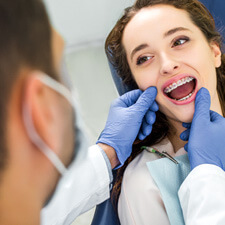Braces – Waco, TX
Traditional Braces Ensure A Reliable Outcome
Traditional braces have been around for over a century, and they still cannot be matched if you need to correct several orthodontic problems in one treatment plan. Metal brackets and wires treat overcrowding, a crossbite, overbite or underbite, as well as crooked teeth and spaces between teeth. Brackets are adhesively bonded to teeth in order to hold the wires in places. With continuous pressure, the wires move your teeth into proper alignment gradually. How long you need to wear your braces will depend on the type of correction that’s needed. For most people, however, orthodontics in Waco take between 12 to 24 months.
Advantages of Traditional Braces

Besides giving you the pleasure and confidence that comes with having a well-aligned smile, traditional braces also help you have better oral health. Straight teeth are easier to clean than crooked teeth, which can trap food and bacteria-filled plaque. And a straight smile can prevent abnormal tooth wear and tear, thereby helping you avoid jaw pain and headaches.
The Process Behind Traditional Braces

Traditional braces in Waco consist of metal brackets that are bonded to the facial side of your teeth; arch wires that clip into the brackets; elastic bands to hold the wires in place; and metal bands that are looped around molars to keep the wires from shifting within the brackets.
About every six to eight weeks you’ll come to see Dr. Winarick to have your braces adjusted. With each visit, your teeth will move closer toward perfect alignment. As you progress through treatment, you will gradually begin to see your smile get straighter and straighter.
When Should Your Child First Be Evaluated for Braces?

The American Association of Orthodontists recommends that children be evaluated for braces by the time they are seven years old. At this point, most children’s permanent front teeth have erupted as well as their first molars.
Dr. Winarick will evaluate your child’s dentition to determine whether or not there are existing or developing eruption problems. She will also check to see if there are problems with the growth of their jaw, protruding teeth or crowded teeth.
After this visit, Dr. Winarick will be able to advise you about whether or not early orthodontic intervention could be helpful to your child.
Understanding the Cost of Traditional Braces

Traditional braces are a complex system of many moving parts that can vary greatly from one patient to the next. Because of this, it can be difficult to quote an exact price when it comes to your orthodontic treatment. This is why at Dental Station Family Dentistry Waco, we feel it’s best to offer you all the details we can about the financial aspects of braces so you can be well-informed before your consultation. Read more below to learn about the various factors that can affect the cost of your treatment.
Factors That Affect the Cost of Traditional Braces

So, why don’t all braces cost the same? Here are a few factors that can make the price of orthodontics fluctuate:
- The Severity of Your Condition: The more teeth that need to move and the more drastic the distances between them, the more complex your care.
- The Length of Your Treatment: Orthodontics can take months or even years to complete. The longer it goes on, the more expensive it ultimately becomes.
- Your Age: As you get older, your jawbone becomes firmer, making your treatment more difficult.
- Necessary Follow-Up Appointments: Your braces will need to be tightened every two to eight weeks depending on your progress.
- Additional Appliances: Many times, you’ll need to wear additional orthodontic devices like elastics, space retainers, palatal expanders, and retainers. Each will come with an associated extra cost.
- Your Compliance with Treatment: The closer you follow Winarick’s instructions, the faster your treatment. However, setbacks will do the opposite.
Professional Braces vs. “DIY” Braces: Which Costs More?

It’s not uncommon to see patients who try to cut corners (and costs) by attempting at-home treatment with various household materials. With the saturation of social media culture and dental “hacks” there’s been a rise in DIY braces using fishing line, super glue, rubber bands, and other objects. While it may be tempting to try these methods yourself, it may end up costing you more in the long run. Here’s how:
- DIY braces can move teeth quickly, but don’t offer long-lasting results like professional ones.
- Wearing DIY braces comes with the risk of damaging your teeth and gums or causing infection. This will end up costing you more in professional care.
- The results of DIY braces are unpredictable at best and can cause substantial damage to the underlying jawbone causing pain or discomfort.
Does Dental Insurance Cover Braces?

Some dental plans will cover the cost of traditional orthodontics, but not all of them. The good news is, if your insurance does provide some coverage for braces, they’ll be more likely to pay for braces than clear aligners. If you need braces out of medical necessity, it further increases your chances of having them at least partially covered by your insurance provider. If you need help sifting through the details to see if you’re covered, our team is more than happy to help you and will even file claims on your behalf!
Options for Making Braces Affordable

We understand that many patients either don’t receive dental insurance through their work or can’t afford it outright. That’s why we offer flexible financing through CareCredit and accept the QCD dental plan. Money should never come between you and the treatment you need, so don’t hesitate to give us a call and ask for a consultation. Dr. Winarick will examine your teeth and lay out all your options so you can decide the best path forward for your future smile.
